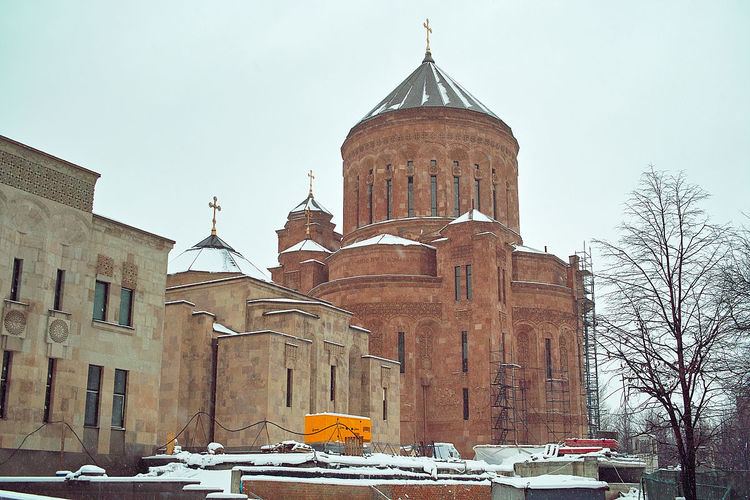 | ||
Armenians in Russia or Russian Armenians are one of the country's largest ethnic minorities and the largest Armenian diaspora community outside of Armenia. The 2010 Russian census recorded 1,182,388 Armenians in the country. Various figures estimate that the ethnic Armenian population in Russia is actually more than 2 million. Armenians populate various regions, including Moscow, Saint Petersburg, Krasnodar Krai in the North Caucasus and as far as Vladivostok in the East.
Contents
Early period
There has been an Armenian presence in Russia since the Late Middle Ages, when various artisans, merchants and traders ventured north to the Crimea and the northern Caucasus in order to set up trade ties and conduct commerce.
Russian Empire
A significant number of Armenians were already living in the Russian Empire before the 1820s. After the destruction of the last remaining independent Armenian states in the Middle Ages, the nobility disintegrated, leaving Armenian society composed of a mass of peasants plus a middle class who were either craftsmen or merchants. Such Armenians were to be found in most towns of Transcaucasia; indeed, at the beginning of the 19th century they formed the majority of the population in cities such as Tbilisi. Armenian merchants conducted their trade across the world and many had set up base within Russia. In 1778, Catherine the Great invited Armenian merchants from the Crimea to Russia and they established a settlement at Nor Nakhichevan near Rostov-on-Don. The Russian ruling classes welcomed the Armenians' entrepreneurial skills as a boost to the economy, but they also regarded them with some suspicion. The image of the Armenian as a "wily merchant" was already widespread. Russian nobles derived their income from their estates worked by serfs and, with their aristocratic distaste for engaging in business, they had little understanding or sympathy for the way of life of mercantile Armenians.
Nevertheless, middle-class Armenians prospered under Russian rule and they were the first to seize the new opportunities and transform themselves into a prosperous bourgeoisie when capitalism and industrialisation came to Transcaucasia in the later half of the 19th century. The Armenians were much more skilled at adapting to the new economic circumstances than their neighbours in Transcaucasia, the Georgians and the Azeris. They became the most powerful element in the municipal life of Tbilisi, the city regarded by Georgians as their capital, and in the late 19th century they began to buy up the lands of the Georgian nobility, who had gone into decline after the emancipation of their serfs. Armenian entrepreneurs were quick to exploit the oil boom which began in Transcaucasia in the 1870s, having large investments in the oil-fields in Baku in Azerbaijan and the refineries of Batumi on the Black Sea coast. All this meant that the tensions between Armenians, Georgians and Azeris in Russian Transcaucasia were not simply ethnic or religious in nature but were due to social and economic factors too. Nevertheless, in spite of the popular image of the typical Armenian as a successful businessman, at the end of the 19th century 80 per cent of Russian Armenians were still peasants working the land.
Russian Federation
According to the Union of Russian Armenians, there are 2.5 million Armenians living in Russia today. According to the same source, about 850,000 are immigrants from Armenia, 350,000 from Azerbaijan and 250,000 from Georgia, including 100,000 from Abkhazia and 180,000 from Central Asia, mostly Tajikistan and Turkmenistan.
The Russian government is encouraging Armenians to immigrate and settle in Russia and is providing financial and settlement incentives.
Armenians in Russia have one of the highest rates of educational attainment. According to the 2002 census 21.4% of Armenians have higher education, 31.8% have "middle special" education (i.e. vocational education), and 46.1% have secondary education.
Moscow
The 2010 Russian census put the number of Moscow Armenians at 106,466. Another 63,306 Armenians lived in Moscow region at the time. There are various estimates on the number of Armenians in Moscow: 400,000, 600,000, 1,000,000. Moscow is often regarded as the largest Armenian community outside of Armenia.
Saint Petersburg
In 1708 the first Armenians came to St. Petersburg, and in 1710 in the city already existed “Armenian offices”. In 1730, under the leadership of the priest Ivan Sheristanova organized the first parish of the Armenian Apostolic Church. Throughout the 20th century Armenian population of St. Petersburg has been steadily increasing. The number of Armenians in St. Petersburg increased from 1,759 in 1926 to 19,164 in 2002.
According to Soviet 1989 census 47% Armenians speak Armenian as native language, 52% speak Russian as native language. At the same time almost all fluent in Russian language. About half of the Armenians have higher education and, consequently, higher social status.
According to the head of Saint Petersburg's Armenian community Karen Mkrtchyan, currently about 100,000 Armenians are living in the region of Saint Petersburg. There are 2 Armenian churches, a Sunday school, "Havatamk" Armenian monthly and a printing house.
Krasnodar
The Krasnodar Krai is one of the biggest communities of the Armenian diaspora. According to the Russian 2002 census, there were 274,566 Armenians. 211,397 of them spoke Armenian as their native language and 6,948 had Armenian citizenship.
According to estimates some 500,000, 700,000 or 1,000,000 Armenians resided in Krasnodar.
They are chiefly concentrated in Greater Sochi (80,045–125,000) the city of Krasnodar (28,022–70,000), the city of Armavir (18,262–50,000) Tuapse (18,194), Novorossiysk (12,092–40,000) Apsheron (10,659), and Anapa (8,201).
Rostov on Don
Historically, the Don region was home to the largest Armenian community on the territory of the modern Russian Federation. Armenians were resettled from Crimean Khanate in 1779 by orders of Catherine the Great and founded several settlements around the territory of modern Rostov-on-Don. The largest of them, Nakhichevan-on-Don, was merged into the Rostov city in 1928. Armenians still constitute the majority of Myasnikovsky District population. In 2010 Rostov-on-Don had the third largest Armenian population of all Russian cities (after Moscow and Sochi, Krasnodar Krai).
